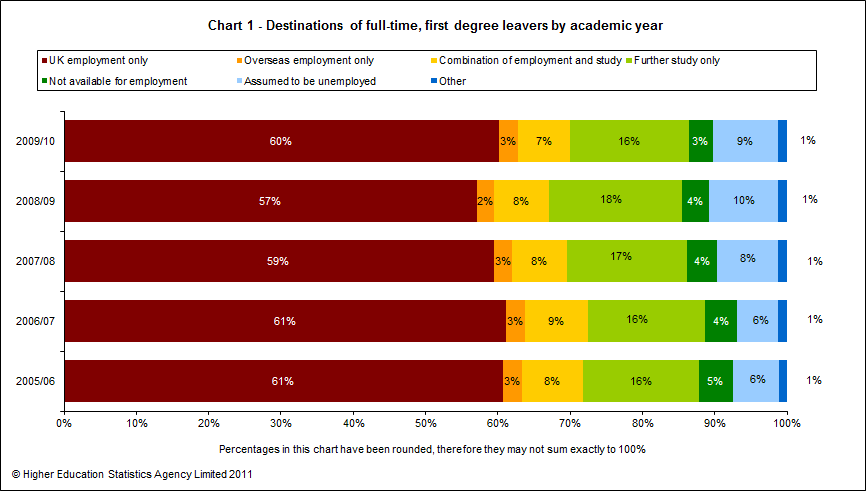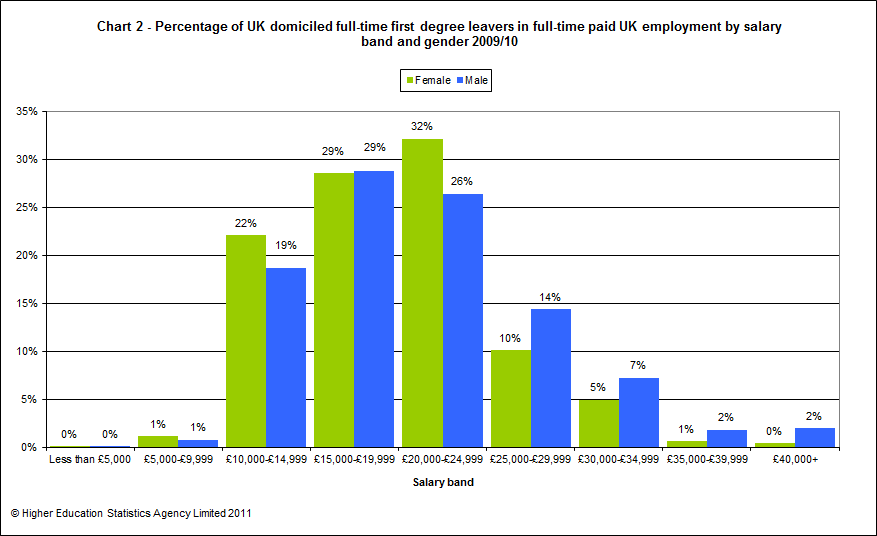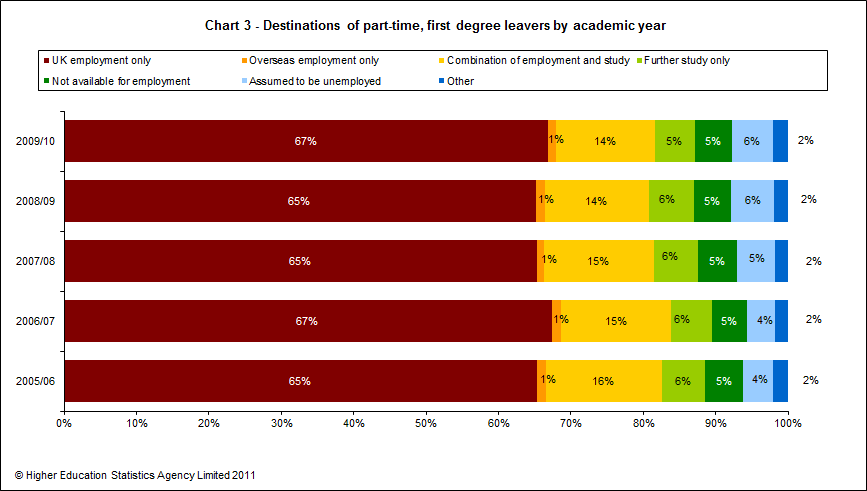Destinations of Leavers from Higher Education in the United Kingdom for the academic year 2009/10
Introduction
This Statistical First Release (SFR) has been produced by the Higher Education Statistics Agency (HESA), in collaboration with statisticians from the Department for Business, Innovation and Skills (BIS), the Welsh Government (WG), the Scottish Government (SG) and the Department for Employment and Learning Northern Ireland (DEL(NI)). It has been released according to the arrangements approved by the UK Statistics Authority. It provides details of the destinations of leavers from higher education (HE) who obtained qualifications in higher education institutions (HEIs) in the United Kingdom (UK), during the academic year 2009/10. The data presented draws on the 2009/10 Destinations of Leavers from Higher Education (DLHE) survey and presents five year time series analyses relating to the 2005/06-2009/10 DLHE surveys.
Summary
In 2009/10, 63% of full-time first degree graduates whose destinations were known were in employment only, 7% were in a combination of employment and study, 16% were in further study only, and 9% were assumed to be unemployed (See Table 1 and Chart 1).
Over the time series shown in this SFR, the proportion in employment and/or study has decreased from 88% in 2005/06 to 86% in 2009/10, reaching a high of 89% in 2006/07 and a low of 85% in 2008/09. The proportion who were assumed to be unemployed has increased from 6% in 2005/06 to 9% in 2009/10, reaching a high of 10% in 2008/09 and a low of 6% in both 2005/06 and 2006/07 (See Table 1 and Chart 1).
Of those UK domiciled, full-time, first degree, graduates who entered full-time paid employment in the UK and provided salary information, the median salary has increased from £18,000 in 2005/06 to £19,000 in 2009/10, whilst the mean salary has increased from £18,500 in 2005/06 to £20,000 in 2009/10. This mean value in 2009/10 was the highest over the five year time period whilst the median reached a high of £20,000 in both 2007/08 and 2008/09 (See Table 5 and note to editor 10).
Of the full-time, first degree graduates who entered employment in the UK, Associate professional & technical occupations represented the largest proportion, with Professional occupations having the second largest proportion, a trend which remained constant across the 5 year time period. Combined, these occupational groups accounted for 56% of all jobs undertaken by these graduates in 2009/10 (See Table 4a).
This SFR also includes information on part-time first degree, postgraduate and other undergraduate leavers. A few of the key points include:
- The proportion of part-time first degree leavers in employment and/or further study decreased from 89% in 2005/06 to 87% in 2009/10, reaching a high of 90% in 2006/07 (See Table 2).
- The proportion of postgraduate leavers (both full-time and part-time, excluding Postgraduate Certificate in Education) in employment and/or further study decreased steadily from 93% in 2005/06 to 90% in 2009/10 (See Tables 1 and 2).
- The proportion of other undergraduate leavers (both full-time and part-time, excluding foundation degree and Professional Graduate Certificate in Education) in employment and/or further study decreased steadily from 93% in 2005/06 to 91% in 2009/10 (See Tables 1 and 2).
Further details and more data breakdowns are shown in the Key Points section below, and also in the tables.
Key Points - All UK HEIs
First degree
- In 2009/10 there were 213,390 full-time first degree graduates whose destinations were known, compared to 205,340 in 2008/09. In 2009/10, 63% (133,940) were in employment only, 59% in 2008/09; 7% (15,505) were in a combination of work and study, 8% in 2008/09; 16% (34,990) were involved in further study only, 18% in 2008/09; and 9% (19,335) were assumed to be unemployed, 10% in 2008/09 (See Table 1 and Chart 1).
- Of the full-time first degree graduates whose destinations were known and reported as being in employment only, 96% (128,340) were employed in the UK, the same as in 2008/09 (See Table 1).
Chart 1 shows the trend of full-time first degree graduate destinations from 2005/06-2009/10.

- In 2009/10 of the full-time first degree graduates who were employed in the UK, 31% of these posts were classified as Associate professional & technical occupations, compared to 29% in 2008/09, 25% as Professional occupations, 26% in 2008/09, 13% as Sales & customer service occupations, 14% in 2008/09, and 9% as Administrative & secretarial occupations, 10% in 2008/09. These are the occupational groups with the highest proportions of leavers (See Table 4a).
- Subjects of study Unemployment rates for full-time first degree graduates whose destinations were known varied between subjects, ranging from those which have traditionally low rates of unemployment, such as Medicine & dentistry (approximately 0%), Veterinary Science 4% and Education 5%, to 13% for Mass communications & documentation and 14% for Computer science (See Table 3).
- Salary Of those UK domiciled, first degree graduates (both full-time and part-time) reported as being in full-time paid employment in the UK in 2009/10, 55% disclosed their salary, 52% in 2008/09. The median salary reported (to the nearest £500) was £20,000, the same as 2008/09. The lower quartile was £15,000 and the upper quartile £24,000. The mean salary was £20,500, the same as in 2008/09 (See Table 5).
Chart 2 shows the salary distribution of UK domiciled, full-time, first degree leavers in full-time paid employment by gender 2009/10.

- Chart 2 shows that a higher proportion of males than females have salaries of £25,000 or more. The difference between the salaries of males and females is further reflected in the mean and median values (not shown in the chart), the median salary for female leavers was £19,000 compared to £20,000 for males, and the mean salary showed a larger difference, £19,000 for females compared to £20,500 for males (See note to editors 10).
- Part-time In 2009/10, of the 22,540 part-time first degree graduates whose destinations were known, 68% (15,325) were in employment only, 66% in 2008/09; 14% (3,075) were in a combination of work and study, the same as in 2008/09; 5% (1,240) were involved in further study only, 6% in 2008/09; and 6% (1,280) were assumed to be unemployed, the same as in 2008/09 (See Table 2 and Chart 3).
Chart 3 shows the trend of part-time first degree graduate destinations from 2005/06-2009/10.

Foundation degree
- In 2009/10, there were 18,105 foundation degree graduates (both full-time and part-time) whose destinations were known, compared to 13,080 in 2008/09. In 2009/10, 38% (6,880) reported their first destination as employment only, 36% in 2008/09; 25% (4,535) were in a combination of work and study, 24% in 2008/09; 32% (5,790) were involved in further study only, 34% in 2008/09; and 3% (485) were assumed to be unemployed, the same as in 2008/09 (See Tables 1 and 2).
Other undergraduate
- In 2009/10, of the 32,940 other undergraduate leavers (both full-time and part-time, excluding foundation degree and Professional Graduate Certificate in Education) and whose destinations were known, 59% (19,275) were in employment only, compared to 58% in 2008/09; 17% (5,560) were in a combination of work and study, 16% in 2008/09; 16% (5,110) were in further study only, 18% in 2008/09; and 5% (1,690) were assumed to be unemployed, 4% in 2008/09 (See Tables 1 and 2).
Postgraduate
- Of the 69,610 former postgraduate students (both full-time and part-time excluding Postgraduate Certificate in Education) whose destinations were known, 72% (50,405) were in employment only, compared to 73% in 2008/09; 9% (6,275) were in a combination of work and study, the same as in 2008/09; 8% (5,785) were involved in further study only, the same as in 2008/09; and 6% (4,350) were assumed to be unemployed, the same as in 2008/09 (See Tables 1 and 2).
Chart 4 shows the destinations of full-time leavers by level of qualification obtained 2009/10.

- Looking at Chart 4, it can be seen that there is a considerable difference in the destinations of leavers depending on the qualifications they have achieved. This is particularly noticeable looking at leavers entering employment only which show 88% for PGCEs compared to 31% for foundation degrees and those entering further study only showing 43% for foundation degrees compared to 3% for doctorates.
Gender
- Overall, in 2009/10 9% of males whose destinations were known were assumed to be unemployed, compared to 6% of females; 10% and 6% respectively in 2008/09 (See Tables 1 and 2 and previous SFR, ref Notes to editors 4).
Key Points - England HEIs only
First degree
- In 2009/10, there were 176,100 full-time first degree graduates whose destinations were known, compared to 168,400 in 2008/09. In 2009/10, 63% (110,830) were in employment only, 59% in 2008/09; 7% (12,720) were in a combination of work and study, 8% in 2008/09; 16% (28,050) were involved in further study only, 18% in 2008/09; and 9% (16,415) were assumed to be unemployed, 10% in 2008/09 (See Table 1a).
- Of the full-time first degree graduates whose destinations were known and reported as being in employment only, 96% (106,405) were employed in the UK, the same as in 2008/09 (See Table 1a).
- In 2009/10 of the full-time first degree graduates who were employed in the UK, 31% of these posts were classified as Associate professional & technical occupations, compared to 30% in 2008/09, 25% as Professional occupations, the same as in 2008/09, 13% as Sales & customer service occupations, the same as in 2008/09, and 10% as Administrative & secretarial occupations, 11% in 2008/09. These are the occupational groups with the highest proportions of leavers (See Table 4a).
- Salary Of those UK domiciled, first degree graduates (both full-time and part-time) reported as being in full-time paid employment in the UK in 2009/10, 57% disclosed their salary, 53% in 2008/09. The median salary reported (to the nearest £500) was £20,000, (the same as in 2008/09). The lower quartile was £15,000 and the upper quartile £24,000. The mean salary was £20,500 (£21,000 in 2008/09) (See Table 5).
- Part-time In 2009/10, of the 19,655 part-time first degree graduates whose destinations were known, 66% (13,065) were in employment only, 65% in 2008/09; 14% (2815) were in a combination of work and study, 15% in 2008/09; 6% (1,120) were involved in further study only, the same as in 2008/09; and 6% (1,145) were assumed to be unemployed, the same as in 2008/09 (See Table 2a).
Foundation degree
- In 2009/10, there were 17,445 foundation degree graduates (both full-time and part-time) whose destinations were known, compared to 12,455 in 2008/09. In 2009/10, 38% (6,655) reported their first destination as employment only, 36% in 2008/09; 25% (4,275) were in a combination of work and study, 24% in 2008/09; 32% (5,640) were involved in further study only, 35% in 2008/09; and 3% (475) were assumed to be unemployed, the same as in 2008/09 (See Tables 1a and 2a).
Other undergraduate
- In 2009/10, of the 27,760 other undergraduate leavers (both full-time and part-time, excluding foundation degree and Professional Graduate Certificate in Education) and whose destinations were known, 60% (16,620) were in employment only, compared to 61% in 2008/09; 17% (4,655) were in a combination of work and study, 16% in 2008/09; 15% (4,035) were in further study only, 16% in 2008/09; and 5% (1,405) were assumed to be unemployed 4% in 2008/09 (See Tables 1a and 2a).
Postgraduate
- Of the 59,180 former postgraduate students (both full-time and part-time excluding Postgraduate Certificate in Education) whose destinations were known, 72% (42,613) were in employment only, the same as in 2008/09; 9% (5,470) were in a combination of work and study, the same as in 2008/09; 8% (4,930) were involved in further study only, the same as in 2008/09; and 6% (3,730) were assumed to be unemployed, the same as in 2008/09 (See Tables 1a and 2a).
Location of employment
- Of the UK domiciled leavers from HEIs in England whose destinations were known and reported as being in employment, 98% (113,545) of full-time first degree graduates found employment in England, 1% (665) in Scotland, 1% (1,290) in Wales and approximately 0% (545) in Northern Ireland. Similarly, 98% (29,460) of postgraduates and 99% (19,105) of other undergraduates found employment in England. This pattern of location of employment is similar to that found in both 2008/09 and 2007/08 (See Table 6a).
- Of the leavers domiciled in England (prior to study), whose destinations were known and reported as being in employment, 98% (114,515) of full-time first degree graduates found employment in England, 1% (905) in Scotland, 1% (1,230) in Wales and approximately 0% (55) in Northern Ireland. Similarly, 98% (29,040) of postgraduates and 99% (18980) of other undergraduates found employment in England. This pattern of location of employment is similar to that found in both 2008/09 and 2007/08 (See Table 6b).
Key Points - Wales HEIs only
First degree
- In 2009/10, there were 12,620 full-time first degree graduates whose destinations were known, compared to 12,290 in 2008/09. In 2009/10 63% (7,900) were in employment only, 60% in 2008/09; 8% (1,005) were in a combination of work and study, the same as in 2008/09; 18% (2,210) were involved in further study only, 19% in 2008/09; and 8% (975) were assumed to be unemployed, the same as in 2008/09 (See Table 1a).
- Of the full-time first degree graduates whose destinations were known and reported as being in employment only, 96% (7,555) were employed in the UK, the same as in 2008/09 (See Table 1a).
- In 2009/10 of the full-time first degree graduates who were employed in the UK, 31% of these posts were classified as Associate professional & technical occupations, the same as in 2008/09, 21% as Professional occupations, 20% in 2008/09, 15% as Sales & customer service occupations, the same as in 2008/09, and 10% as Administrative & secretarial occupations, 12% in 2008/09. These are the occupational groups with the highest proportions of leavers (See Table 4a).
- Salary Of those UK domiciled, first degree graduates (both full-time and part-time) reported as being in full-time paid employment in the UK in 2009/10, 35% disclosed their salary, 39% in 2008/09. The median salary reported (to the nearest £500) was £19,000 (the same as in 2008/09). The lower quartile was £14,500 and the upper quartile £22,000. The mean salary was £19,000 (£19,500 in 2008/09) (See Table 5).
- Part-time In 2009/10, of the 750 part-time first degree graduates whose destinations were known, 75% (560) were in employment only, 73% in 2008/09; 14% (105) were in a combination of work and study, 13% in 2008/09; 3% (25) were involved in further study only, 5% in 2008/09; and 3% (20) were assumed to be unemployed, the same as in 2008/09 (See Table 2a).
Foundation degree
- In 2009/10, there were 625 foundation degree graduates (both full-time and part-time) whose destinations were known, compared to 585 in 2008/09. In 2009/10, 33% (210) reported their first destination as employment only, 38% in 2008/09; 40% (250) were in a combination of work and study, 32% in 2008/09; 23% (145) were involved in further study only, 24% in 2008/09; and 2% (10) were assumed to be unemployed, 3% in 2008/09 (See Tables 1a and 2a).
Other undergraduate
- In 2009/10, of the 2,195 other undergraduate leavers (both full-time and part-time, excluding foundation degree and Professional Graduate Certificate in Education) and whose destinations were known, 50% (1,110) were in employment only, the same as in 2008/09; 20% (450) were in a combination of work and study, 24% in 2008/09; 19% (425) were in further study only, 18% in 2008/09; and 5% (110) were assumed to be unemployed, 4% in 2008/09 (See Tables 1a and 2a).
Postgraduate
- Of the 2,940 former postgraduate students (both full-time and part-time excluding Postgraduate Certificate in Education) whose destinations were known, 73% (2,160) were in employment only, compared to 72% in 2008/09; 10% (290) were in a combination of work and study, the same as in 2008/09; 7% (205) were involved in further study only, the same as in 2008/09; and 6% (175) were assumed to be unemployed, the same as in 2008/09 (See Tables 1a and 2a).
Location of employment
- For UK domiciled leavers from HEIs in Wales whose destinations were known and reported as being in employment, 66% (1,305) of full-time postgraduate leavers, 63% (5,260) of full-time first degree leavers and 84% (535) of full-time other undergraduate leavers were employed in Wales. Most of those not employed in Wales were employed in England. These proportions are similar to those for 2008/09 leavers (See Table 6a).
- Of the leavers domiciled in Wales (prior to study), whose destinations were known and reported as being in employment, 75% (5,295) of full-time first degree graduates found employment in Wales, 25% (1,755) in England, and approximately 0% in both Scotland and Northern Ireland. Similarly, 66% (1,340) of postgraduates and 80% (575) of other undergraduates found employment in Wales (See Table 6b).
Key Points - Scotland HEIs only
First degree
- In 2009/10, there were 19,035 full-time first degree graduates whose destinations were known, compared to 18,985 in 2008/09. In 2009/10, 62% (11,815) were in employment only, 58% in 2008/09; 6% (1210) were in a combination of work and study, 7% in 2008/09; 20% (3,815) were involved in further study only, 23% in 2008/09; and 7% (1,385) were assumed to be unemployed, the same as in 2008/09 (See Table 1a).
- Of the full-time first degree graduates whose destinations were known and reported as being in employment only, 95% (11,180) were employed in the UK, the same as in 2008/09 (See Table 1a).
- In 2009/10 of the full-time first degree graduates who were employed in the UK, 28% of these posts were classified as Associate professional & technical occupations, the same as in 2008/09, 31% as Professional occupations, the same as in 2008/09, 13% as Sales & customer service occupations, the same as in 2008/09, and 8% as Administrative & secretarial occupations, 9% in 2008/09. These are the occupational groups with the highest proportions of leavers (See Table 4a).
- Salary Of those UK domiciled, first degree graduates (both full-time and part-time) reported as being in full-time paid employment in the UK in 2009/10, 48% disclosed their salary, 46% in 2008/09. The median salary reported (to the nearest £500) was £21,000, (the same as in 2008/09).The lower quartile was £16,000 and the upper quartile £25,000. The mean salary was £21,500 (the same as in 2008/09) (See Table 5).
- Part-time In 2009/10, of the 1,470 part-time first degree graduates whose destinations were known, 81% (1,190) were in employment only, 79% in 2008/09; 8% (110) were in a combination of work and study, 10% in 2008/09; 4% (65) were involved in further study only, 6% in 2008/09; and 4% (60) were assumed to be unemployed, 2% in 2008/09 (See Table 2a).
Other undergraduate
- In 2009/10, of the 2,720 other undergraduate leavers (both full-time and part-time) and whose destinations were known, 50% (1355) were in employment only, compared to 45% in 2008/09; 15% (410) were in a combination of work and study, 10% 2008/09; 24% (640) were in further study only, 36% in 2008/09; and 6% (170) were assumed to be unemployed, 5% in 2008/09 (See Tables 1a and 2a).
Postgraduate
- Of the 5,695 former postgraduate students (both full-time and part-time excluding Postgraduate Certificate in Education) whose destinations were known, 74% (4,190) were in employment only, compared to 76% in 2008/09; 7% (420) were in a combination of work and study, the same as in 2008/09; 10% (545) were involved in further study only, 8% in 2008/09; and 6% (345) were assumed to be unemployed, the same as in 2008/09 (See Tables 1a and 2a).
Location of employment
- Of UK domiciled, full-time graduates from HEIs in Scotland whose destinations were known and reported as being in employment, 85% (14,070) were employed in Scotland, 13% (2,150), approximately 0% (40) and 1% (220) were employed in England, Wales and Northern Ireland respectively. Of full-time first degree graduates from Scottish HEIs 83% (9915) stayed in Scotland to work, compared to 89% (3,150) of postgraduates and 95% (1,005) of other undergraduates (See Table 6a).
- Of full-time graduates domiciled in Scotland (prior to study), whose destinations were known and reported as being in employment, 88% (13,470) were employed in Scotland, the remainder were mainly employed in England. Of full-time first degree graduates domiciled from Scotland 88% (9,420) stayed in Scotland to work, compared to 88% (3,030) of postgraduates and 95% (1,020) of other undergraduates (See Table 6b).
Key Points - Northern Ireland HEIs only
First degree
- In 2009/10, there were 5,630 full-time first degree graduates whose destinations were known, compared to 5,670 in 2008/09. In 2009/10, 60% (3,395) were in employment only, 61% in 2008/09; 10% (570) were in a combination of work and study, the same as in 2008/09; 16% (915) were involved in further study only, 17% in 2008/09; and 10% (560) were assumed to be unemployed, 9% in 2008/09 (See Table 1a).
- Of the full-time first degree graduates whose destinations were known and reported as being in employment only, 94% (3,200) were employed in the UK, compared to 96% in 2008/09 (See Table 1a).
- In 2009/10 of the full-time first degree graduates who were employed in the UK, 32% were classified as Professional occupations, the same as in 2008/09,18% as Associate professional & technical occupations, compared to 20% in 2008/09, 22% as Sales & customer service occupations, 21% in 2008/09, and 8% as Administrative & secretarial occupations, the same as in 2008/09. These are the occupational groups with the highest proportions of leavers (See Table 4a).
- Salary Of those UK domiciled, first degree graduates (both full-time and part-time) reported as being in full-time paid employment in the UK in 2009/10, 45% disclosed their salary, 47% in 2008/09. The median salary reported (to the nearest £500) was £18,000, (£19,000 in 2008/09). The lower quartile was £14,000 and the upper quartile £22,000. The mean salary was £19,000 (the same as in 2008/09) (See Table 5).
- Part-time In 2009/10, of the 665 part-time first degree graduates whose destinations were known, 77% (510) were in employment only, the same as in 2008/09; 7% (45) were in a combination of work and study, 10% in 2008/09; 5% (30) were involved in further study only, the same as in 2008/09; and 8% (50) were assumed to be unemployed, 4% in 2008/09 (See Table 2a).
Other undergraduate
- In 2009/10, of the 265 other undergraduate leavers (both full-time and part-time, excluding foundation degree) and whose destinations were known, 72% (195) were in employment only, compared to 63% in 2008/09; 18% (45) were in a combination of work and study, 19% in 2008/09; 4% (10) were in further study only, 11% in 2008/09; and 3% (5) were assumed to be unemployed, 4% in 2008/09 (See Tables 1a and 2a).
Postgraduate
- Of the 1,800 former postgraduate students (both full-time and part-time excluding Postgraduate Certificate in Education) whose destinations were known, 80% (1,445) were in employment only, compared to 79% in 2008/09; 5% (100) were in a combination of work and study, 8% in 2008/09; 6% (100) were involved in further study only, 5% in 2008/09; and 6% (105) were assumed to be unemployed, 5% in 2008/09 (See Tables 1a and 2a).
Location of employment
- Of the UK domiciled full-time leavers from HEIs in Northern Ireland, whose destinations were known and reported as being in employment in the UK, 93%(3,450) of first degree leavers remained in Northern Ireland to take up employment and 7% (250) went to Great Britain. 95% (600) of postgraduate leavers remained in Northern Ireland to take up employment and 5% (30) went to Great Britain (See Table 6a).
- Of the Northern Ireland domiciled full-time leavers from UK Higher Education Institutions, whose destinations were known and reported as being in employment in the UK, 78%(4,115) of first degree leavers took up employment in Northern Ireland and 22% (1,160) went to Great Britain. 70% (750) of postgraduate leavers took up employment in Northern Ireland and 30% (320) went to Great Britain (See Table 6b).
Tables
Table 1: Destinations of full-time leavers by gender, activity and level of qualification obtained, 2005/06-2009/10.
Table 1a: Destinations of full-time leavers by location of institution, activity and level of qualification obtained, 2005/06-2009/10.
Table 2: Destinations of part-time leavers by gender, activity and level of qualification obtained, 2005/06-2009/10.
Table 2a: Destinations of part-time leavers by location of institution, activity and level of qualification obtained, 2005/06-2009/10.
Table 3: Destinations of full-time first degree leavers by gender, activity and subject area, 2005/06-2009/10.
Table 4a: Occupation of full-time first degree leavers entering employment in the UK by location of institution and subject area, 2005/06-2009/10.
Table 4b: Industry of full-time first degree leavers entering employment in the UK by location of institution and subject area, 2005/06-2009/10.
Table 5: UK domiciled leavers who obtained first degree qualifications and entered full-time paid employment in the UK by location of institution, mode of study and salary, 2005/06-2009/10.
Table 6a: Full-time UK domiciled leavers who entered employment within the UK by location of study, level of qualification obtained and location of employment, 2005/06-2009/10.
Table 6b: Full-time UK domiciled leavers who entered employment within the UK by domicile, level of qualification obtained and location of employment 2005/06-2009/10.
None of the tables presented should be interpreted without reference to the Notes to editors and Definitions provided below.
Notes to Editors
- The statistics in this SFR are derived by HESA from data collected from all publicly-funded higher education institutions (HEIs) in the UK (including The Open University) and from The University of Buckingham, which is privately funded. The figures therefore exclude HE qualifications obtained by students at further education colleges and at other private and independent HE providers.
- The 2009/10 Destinations of Leavers from Higher Education (DLHE) data includes all those students whose study was full-time or part-time (see Definition 5) and who obtained relevant qualifications (see Definition 4) reported to HESA for the reporting period 1 August 2009 to 31 July 2010.
-
The HESA DLHE Target Population contains all UK and European Union domiciled HE students for whom destinations data is expected and sought (see Definition 6). The figures presented in this SFR are based on information obtained by institutions and returned to HESA. Where the category ‘unknown' appears, the data relates both to non-respondents and to those leavers who have explicitly refused to answer the survey. Data on the number of unknowns is obtained by cross-checking the actual respondents with the total expected to reply, as returned in the 2009/10 HESA Student record.
In 2009/10, 313,530 full-time qualifiers responded from a target population of 392,100, which amounts to an overall response rate of 80% compared to 79% in 2008/09. 82,270 part-time qualifiers responded from a target population of 109,440, an overall response rate of 75% compared to 74% in 2008/09. These response rates include explicit refusals and are calculated separately from this SFR. They will be presented in a reference volume published by HESA in July 2011 (see Note 4).
In this SFR the figures for whom destinations are known exclude explicit refusals, for which no other information is available. It can be seen from Table 1 that the percentage of records returned for full-time HE students is 77% (77% in 2008/09) and from Table 2 for part-time HE students 71% (70% in 2008/09).
-
An electronic publication ‘Destinations of Leavers from Higher Education 2009/10', setting out more information about the destinations of students qualifying from HEIs in the UK, will be published by HESA in July 2011.
The 2008/09 DLHE SFR can be found here.
-
The Joint Academic Coding System (JACS) of subject classification has been used as the basis for HESA data collections and this SFR. A variant of the SOC2000 was created for the coding of occupational information for use in the DLHE survey; this classification is termed SOC(DLHE).
From 2008/09 the aggregations reflect the Standard Industrial Classification economic activity sections as summarised in the UK Standard Industrial Classification of Economic Activities 2007 (SIC 2007). To enable production of comparable time series the new SIC categories have been grouped to fit with the old categories using: www.statistics.gov.uk/methods_quality/sic/downloads/SIC2007explanatorynotes.pdf.
- 55% of UK domiciled leavers who obtained first degree qualifications and entered full-time paid employment in the UK disclosed their salary. The equivalent percentages for the administrations are as follows: England (57%), Wales (35%), Scotland (48%), and Northern Ireland (45%). HESA therefore advises caution in analysis of leavers by salary.
- The qualification acronym ‘PGCE' has traditionally been an abbreviation of ‘Postgraduate Certificate in Education'. However, the academic level of PGCE courses does vary. In April 2005 the Quality Assurance Agency for Higher Education issued guidance in relation to the Framework for HE Qualifications, which introduced a distinction between those PGCEs pitched at a level equivalent to the final year of an undergraduate Honours degree and those pitched beyond Honours level. The existing postgraduate level qualification was augmented by a new undergraduate level version, entitled the ‘Professional Graduate Certificate in Education'. This change was reflected in the HESA Student Record from 2008/09. For purposes of time series in this SFR, within Tables 1,1a, 2 and 2a where PGCEs are shown separately both postgraduate and undergraduate versions are included. Where the level of study disaggregation does not show PGCEs separately, ‘Postgraduate Certificates in Education' are included in ‘Postgraduate' totals and ‘Professional Graduate Certificates in Education' are included in ‘Other undergraduate' totals.
- The wording of the further study question within the DLHE questionnaire was altered from 2007/08 to clarify that leavers registered as research students, not those employed as researchers, should respond to this question. The resulting effect of this change can be seen most notably in the fall in proportion of doctorate leavers appearing within the combination of employment and study category from the equivalent figure for 2006/07.
- Within this SFR, where the phrase "same as in the previous year" is stated, this relates to the corresponding percentage rather than the underlying numbers.
- When comparing mean and median salaries, it should be noted that whilst a mean shows the arithmetic average salary, this could be skewed by a few abnormally high or low values. The median takes the middle value and is therefore less affected by very high or low salaries.
Definitions
- HE students are those students on courses for which the level of instruction is above that of the Qualifications and Curriculum Development Agency (QCDA) National Qualifications Framework (NQF)/Qualifications and Credit Framework (QCF) level 3 (or equivalent) e.g. courses at the level of Certificate of HE and above.
-
The survey dates for this DLHE return were 19 April 2010 (if the leaver obtained the qualification between 1 August 2009 and 31 December 2009) and 10 January 2011 (if the leaver obtained the qualification between 1 January 2010 and 31 July 2010). The reference dates of the 2008/09 DLHE return were 20 April 2009 and 11 January 2010 respectively.
Leavers separately report what they are doing in relation to employment and study; this enables the following destination categories to be derived from DLHE:
- Employment only
- Combination of work and study
- Further study only
- Assumed to be unemployed.
In addition, the destination category combination of work and study can be aggregated with the explicit employment only and further study only categories as follows:
- In employment only or a combination of work and study
- In study only or a combination of work and study.
For further details see Definitions 8 to 10.
-
Qualifications
Relevant qualifications for inclusion in the 2009/10 DLHE return are listed in Definition 4 below.
The population for the DLHE return does not necessarily represent the full cohort graduating during the reporting period; examples of those excluded are professional qualifications (e.g. associate membership or membership of a body such as the Institute of Bankers) and undergraduate diplomas and certificates (other than foundation degrees, HND, DipHE, HNC and CertHE).
-
Level of qualification obtained
Postgraduate qualifications obtained includes doctorate degrees obtained/not obtained primarily through research and New Route PhD; masters degrees obtained/not obtained primarily through research, Masters in Teaching and Learning, pre-registration masters degrees leading towards obtaining eligibility to register to practice with a health or social care or veterinary statutory regulatory body and postgraduate bachelors degrees; postgraduate diplomas, certificates and professional qualifications, Postgraduate Certificates in Education or Professional Graduate Diplomas in Education; other taught qualifications at level M including those leading towards registration with the Architects Registration Board (Part 2 qualification); level 7 Diploma in Teaching in the Lifelong Learning Sector, institutional postgraduate credits and non-formal postgraduate qualifications.
In certain analyses where PGCE is shown separately, this includes both Postgraduate Certificates in Education/Professional Graduate Diplomas in Education and Professional Graduate Certificates in Education.
In analyses where postgraduate qualification obtained is disaggregated into Doctorate and Other postgraduate the following groupings are used:
Doctorate qualifications obtained includes qualifications obtained includes doctorate degrees obtained/not obtained primarily through research and New Route PhD.
Other postgraduate qualifications obtained includes masters degrees obtained/not obtained primarily through research, Masters in Teaching and Learning, pre-registration masters degrees leading towards obtaining eligibility to register to practice with a health or social care or veterinary statutory regulatory body and postgraduate bachelors degrees; postgraduate diplomas, certificates and professional qualifications; other taught qualifications at level M including those leading towards registration with the Architects Registration Board (Part 2 qualification); level 7 Diploma in Teaching in the Lifelong Learning Sector, institutional postgraduate credits and non-formal postgraduate qualifications.
First degree qualifications obtained includes integrated undergraduate/postgraduate taught masters degrees on the enhanced/extended pattern, and first degrees with honours on the enhanced/extended pattern at level H; first degrees with honours/ordinary first degrees (including those leading to qualified teacher status (QTS)/registration with a General Teaching Council (GTC), but excluding those from the intercalated pattern); first degrees with honours leading towards registration with the Architects Registration Board (Part 1 qualification); pre-registration first degrees with honours/ordinary first degrees leading towards obtaining eligibility to register to practice with a health or social care or veterinary statutory regulatory body; first degrees with honours and diploma; postgraduate bachelors degrees at level H, and diploma at level M.
Other undergraduate includes qualification aims equivalent to and below first degree level, including, but not limited to, Professional Graduate Certificate in Education (PGCE) at level H (unless shown separately), foundation degrees (unless shown separately), diplomas in higher education (including those with eligibility to register to practice with a health or social care or veterinary statutory regulatory body), Higher National Diploma (HND), Higher National Certificate (HNC), Diploma of Higher Education (DipHE), Certificate of Higher Education (CertHE), foundation courses at higher education level, National Vocational Qualification (NVQ)/Scottish Vocational Qualification (SVQ) at NQF levels 4 and 5, post-degree diplomas and certificates at undergraduate level (including those in Teaching in the Lifelong Learning Sector), professional qualifications at undergraduate level, other undergraduate diplomas and certificates including post-registration health and social care courses, other formal higher education qualifications of less than degree standard, institutional undergraduate credit and non-formal undergraduate qualifications.
In certain analyses Foundation degrees (e.g. FdA, FdSc) are shown separately. Foundation degrees were first introduced in September 2001 to provide vocational higher education qualifications.
Further details of the frameworks used to classify courses are available here.
-
Mode of study
Full-time includes full-time and sandwich modes plus those writing-up where the mode of study was previously full-time and students changing to dormant status previously full-time.
Part-time includes those studying part-time, full-time for less than 24 weeks in the academic year, block release or studying during the evenings, plus those writing-up theses and previously part-time.
-
Domicile
UK domicile students are those whose normal residence is in the UK, including those living in Guernsey, Jersey and the Isle of Man. Other European Union (Other EU) domicile students are those whose normal residence is in countries which were EU members or in their designated territories as at 1 December 2009.
-
Location of employment
Respondents to the HESA DLHE survey were asked to supply the location of their employment. Where this was unknown but the activity was full-time paid work only (including self-employed), part-time paid work only or voluntary/unpaid work only, a United Kingdom location of employment has been assumed. These numbers are, however, relatively small. The unknown location of employment assumed to be in UK employment is 0.2% of the total of UK Employment for Table 1 and 0.4% for Table 2.
Where location of employment is given as Great Britain, this is taken to be England, Scotland and Wales only (i.e. it excludes those located in Guernsey, Jersey or the Isle of Man).
-
Employment
The category Employment only includes those students who gave their employment circumstances as employed full-time, employed part-time, self-employed/freelance, voluntary work/other unpaid work and who are also not in study.
The category Combination of work and study includes those students who gave their employment circumstances as employed full-time, employed part-time, self-employed/freelance, voluntary work/other unpaid work and who are also either in full-time study or part-time study.
The category Full-time employment only includes those students who gave their employment circumstances as employed full-time or self-employed/freelance and who are also not in study.
-
Further study
The category Further study includes those who gave their employment circumstances as temporarily sick or unable to work/looking after the home or family, not employed but not looking for employment, further study or training, or something else, and who were also either in full-time or part-time study, training or research. It also includes those who were due to start a job within the next month or unemployed and looking for employment, further study or training, and who were also in full-time study, training or research.
-
Unemployment
The category Assumed to be unemployed includes those students who gave their employment circumstances as unemployed and looking for employment, further study or training and also includes those due to start work within one month, unless leaver is also in full-time study.
In Tables 1, 1a, 2, 2a and 3, the category Other includes those students who are not in study and also either gave their employment circumstances as not employed but NOT looking for employment, further study or training, or something else.
-
Unknown
This category includes non-respondents and explicit refusals, and is used in Tables 1, 1a, 2, 2a and 3.
-
Salary
Describes the annual salary surveyed to the nearest thousand pounds before tax, for leavers in full-time paid employment. Provision of salary information may legitimately be refused. Salary calculations in Table 5 are expressed to the nearest £500.
-
Location of institution
The allocation of an institution to a geographical region is done by reference to the administrative centre of that institution. There may be students registered at institutions who are studying in regions other than that of the administrative centre of the institution.
The The Open University is counted as a wholly English institution. The administrative centre is located in England, although The Open University teaches throughout the UK.
-
Rounding Strategy
In the text and tables the figures presented are rounded. 0, 1 and 2 are rounded to 0. All other numbers are rounded up or down, to the nearest multiple of 5. This rounding strategy is also applied to totals figures, a consequence of which is that the sum of numbers in each row or column rarely precisely matches the totals shown. Percentages are calculated on the base data and are suppressed if they are calculated on a population which contains 52 or fewer individuals. These cases are represented as '..'.
Press enquiries should be directed to the Press Office at the Higher Education Statistics Agency (HESA), 95 Promenade, Cheltenham, GL50 1HZ, telephone 01242 211120. General enquiries about the data contained within this SFR should be addressed to James McLaren, Information Provision Manager, HESA (at the same address), telephone 01242 211133.
Ends

Embargo
30 June 2011, 9:30
Coverage
UK
Themes
Children, education and skills
Issued by
HESA, 95 Promenade, Cheltenham, GL50 1HZ
Press enquiries
01242 211120
Public enquiries
01242 211133
Statistician
James McLaren




